Neil Patel Advanced Marketing Program Free Download
[LIMITED SPOTS] Want To Uncover Your True Potential and Achieve Financial Freedom? We invite you to join a FREE Masterclass with award-winning business leader, Eric Siu, where he shares his 5-Step Blueprint to Starting Your Dream Online Business That Gives You Freedom & Fulfillment.
Click Here To Reserve Your Spot Now.
Updated October 2021
The key to automating a consistent flow of qualified leads is setting up a quality marketing funnel.
And in this comprehensive guide, we'll show you just how to do that. When it comes to creating a powerful marketing funnel, we'll cover:
- What a marketing funnel is (+ examples)
- The five stages of a marketing funnel (+ the AIDA funnel)
- How to create each stage of your funnel
- Qualifying leads in your funnel
Easier said than done, right?
If you need help and just want to create a simple marketing funnels that best fulfills your needs, read on!
TABLE OF CONTENTS: ↓
- What Is a Marketing Funnel?
- What Is an Example of a Marketing Funnel?
- How Does a Marketing Funnel Work? (Stages of the Funnel)
- Stage 1 – Problem/Need Recognition (TOFU)
- Stage 2 – Information Search (MOFU)
- Stage 3 – Evaluation of Alternatives (MOFU)
- Stage 4 – Purchase Decision (BOFU)
- Stage 5 – Post-Purchase Behavior
- AIDA: Another Way to Remember Content Creation Stages
- How to Build a Marketing Funnel for Your Content
- Stage 1 Channels – Problem/Need Recognition (TOFU)
- Stage 2 Channels – Information Search (MOFU)
- Look for 'Striking Distance' Keywords
- Stage 3 Channels – Evaluation of Alternatives (MOFU)
- Stage 4 Channels – Purchase Decision (BOFU)
- Qualifying Leads in Your Sales Funnel: MQLs and SQLs
- What Is a Marketing Qualified Leads (MQL)?
- What Is a Sales Qualified Lead (SQL)?
- Which Marketing Funnel Metrics Should I Track?
What Is a Marketing Funnel?
A marketing funnel – aka purchase funnel – is a roadmap laid out by a company to guide potential customers from their first interaction with the brand to becoming a paying customer.
This roadmap usually consists of paid ads, social media, SEO, content marketing, and many other channels.
While the concept is simple enough, marketing funnels can be very complex for a multitude of reasons, including:
- There are many different marketing channels to choose from (paid ads, SEO, etc.)
- Your customers may have varied pain points (a doctor who wants a survey tool may have different needs from a teacher who needs a survey tool)
- Every customer has a different level of awareness (some have heard of your brand and are looking at alternatives and others don't even know that solutions exist)
Given these variables, it's easy to understand how creating a marketing funnel can quickly become very complex.
Even if you've never sat down to formally create a marketing funnel, you probably already have a funnel without knowing it. Here's an example of what a marketing funnel might look like:
However, the reality is that most businesses have multiple funnels. In addition to capturing people through blog posts, a business might also capture prospects through paid ads, influencer marketing, or some other channel.
I'll discuss how to choose which channel to target, but for now don't assume there is only one way to capture new prospects.
Related Content:
* What's the Right Content for Each Stage of the Marketing Funnel?
* 3 Scalable Content Promotion Strategies to Blast Your Funnel
* The Types of Videos to Use at Each Stage of the Marketing Funnel
What Is an Example of a Marketing Funnel?
An example of a marketing funnel or purchase funnel could be someone who travels the buying journey via:
- Blog Post > Email List > Conversion
- Podcast Ad > Blog Post > Conversion
- Facebook Ad > Landing Page > Conversion
- Influencer Social Post > Landing Page > Conversion
Basically, if people are purchasing your product or service online, you have a marketing funnel whether you know it or not.
Here's an important thing to keep in mind: Although your marketing model may appear quite clear and simple on paper, it is not always that linear in real life. There are often regressions and jumps as people actually go through your marketing funnel.
For example, in the marketing funnel below, even though both Customer A and Customer B came in through content marketing, they had very different customer journeys and experienced the purchase funnel differently:
This is one of the reasons why our strategy at Single Grain is to create an omnichannel marketing plan – because you never know where you will capture potential customers. Even after a customer has made a purchase, your funnel can continue with cross-sells and upsells.
Now that you know what a funnel is and how it works, you're probably wondering how to build one that uses the channels most appropriate for your business and isn't ridiculously complicated.
After creating a marketing funnel that earns our business enough valuable leads to sustain a seven-figure revenue, I wanted to share a marketing funnel framework that will help you reliably generate leads regardless of your current available resources and industry.
Book My Free Marketing Consultation
How Does a Marketing Funnel Work? (Stages of the Funnel)
If you've ever used a paper funnel at the gas station to help you pour oil directly into your car's oil reservoir and not all over the engine, then you understand the basic idea of how a funnel works.
A marketing funnel works via stages, from the broader section at the top (Top of Funnel) that pulls in many people, through the narrower section in the middle (Middle of Funnel), and down to the even narrower section at the bottom (Bottom of Funnel) that is populated by serious buyers:
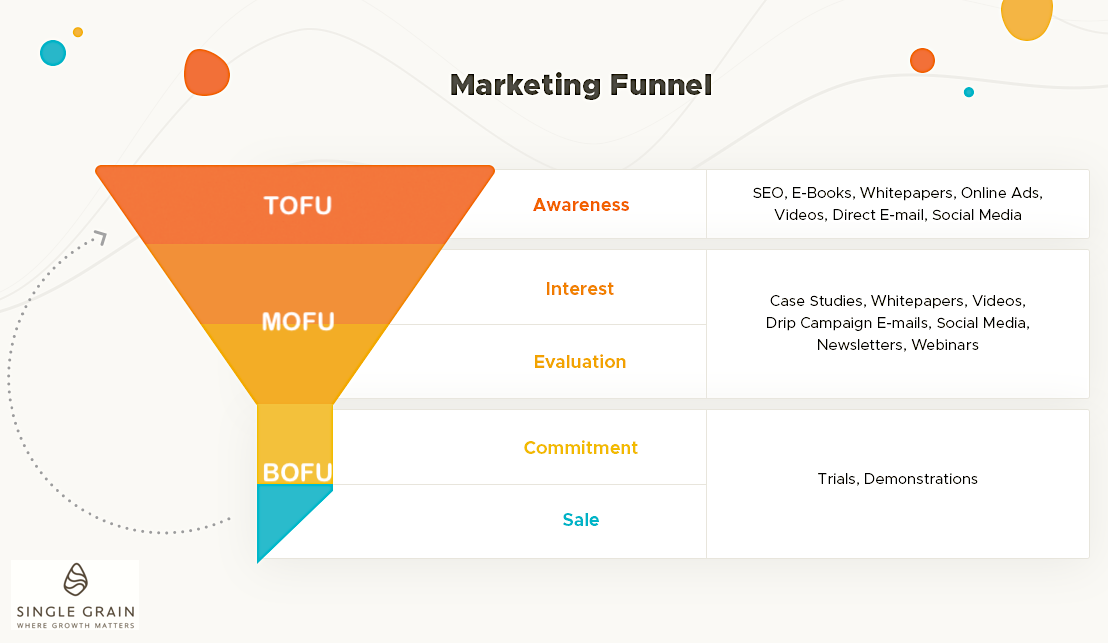
That's why the most important thing to understand when it comes to building a marketing or purchase funnel is that you need to look at it from the customer's perspective. Doing so will save you a lot of guesswork and headaches.
With this in mind, let's look at the various stages of the marketing funnel that customers experience.
Stage 1 – Problem/Need Recognition (TOFU)
Recognizing that you have a problem is the beginning of the buying process.
If you don't know you have a problem, why would you purchase a solution for it? You may have gum disease, but if you don't see or feel anything out of the ordinary in your mouth, it won't even occur to you to do an online search for gum disease.
On the other hand, if your furnace goes out in the middle of winter, you immediately know that you have an issue and will quickly jump to the next step (information search) in the buying process. You may do a little bit of research, but because your problem is so pressing, you won't take long.
Other products or services will require much more education. An example might be purchasing a pharmaceutical drug. In this case, a person may recognize a physical symptom ("problem"), but it might persist for some time before they take action and look for a solution.
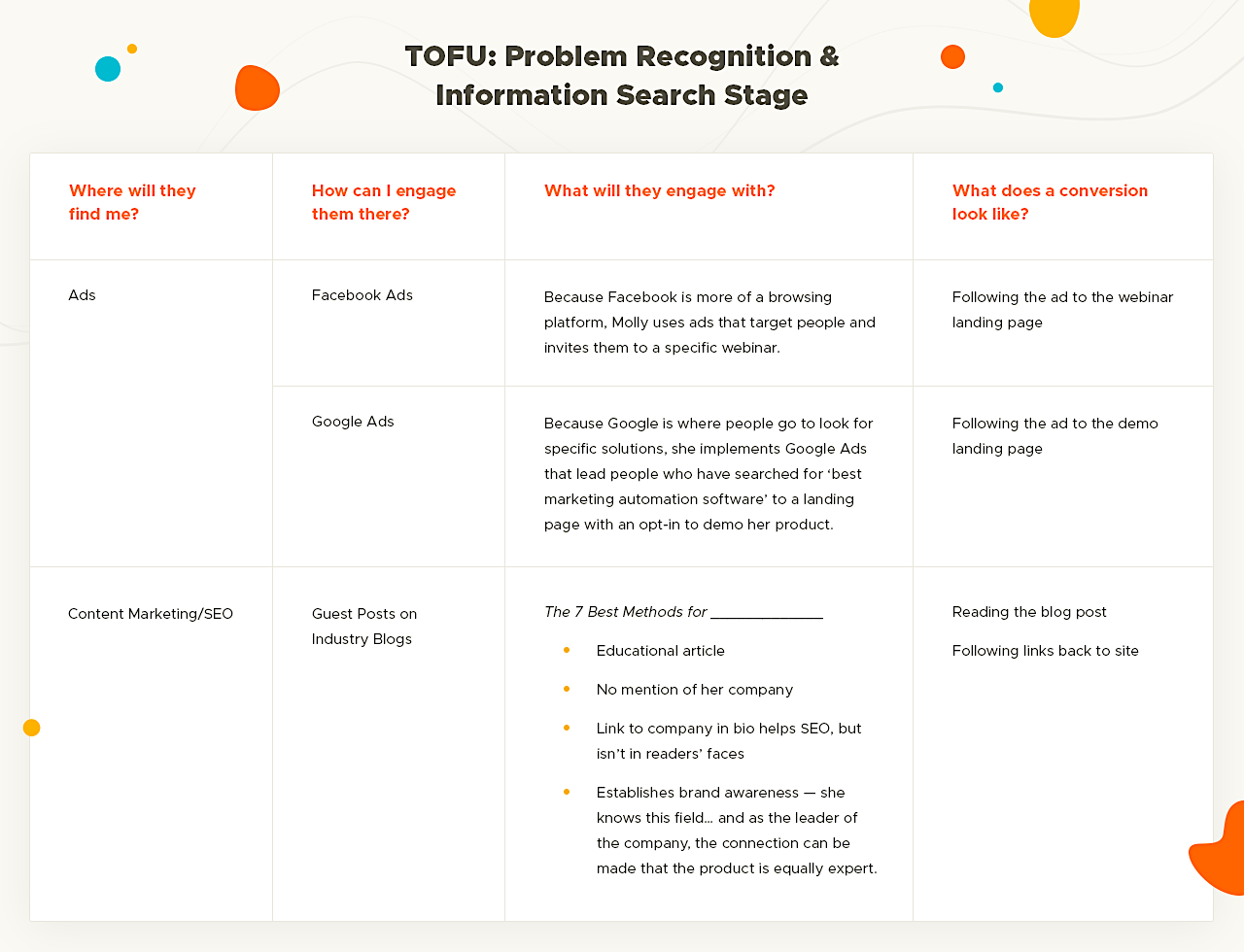
Stage 2 – Information Search (MOFU)
Recognizing a problem or need is the step that triggers a search for more information and brings potential leads to the second stage of the funnel.
The strategies used to gather information tend to vary based on the size and scope of the purchase. Recognizing that you're hungry, for example, might result in a quick Yelp search for restaurants in your area. Deciding which provider to hire to install a new in-ground pool at your home, on the other hand, will involve doing some research online, calling around, reading customer reviews, visiting showrooms, and talking with salespeople.
According to Trust Radius, in 2021 about 33% of buyers spent more time researching products prior to purchasing than they did last year, suggesting that this stage of the funnel is becoming more in-depth. At this point, people aren't looking for promotional content; they're looking to learn more about potential solutions for their need.
Stage 3 – Evaluation of Alternatives (MOFU)
Once customers are aware of a solution, the next step is to compare the alternatives that your article or ad has discussed. Again, the time spent in this stage will vary based on the type of purchase being contemplated. Choosing a restaurant might be as simple as deciding, "Well, I feel like Chinese food, not Mexican, tonight."
But say the customer is evaluating marketing automation programs to help improve the sales funnel they created. Because these programs can require investments of $1,500 a month, they're likely to undergo a much more careful and thorough evaluation process. They might request free trials of the different systems they're considering, have online demonstrations with each company's representatives or view training videos to get a feel for how each system will perform.
If you're running an accounting business, at this stage your customers would be evaluating different potential service providers. They might need resources like pricing guides (so they know what ballpark rates are), how to evaluate the landscape of accounting services (i.e. whether to hire a solo accountant, an agency, etc.), or how to choose an accountant.
If you're running a marketing services business, you might create content about:
- how to choose a marketing agency
- agency pricing guides
- whether a company should go contract or hire in-house
The above examples are non-promotional, educational content resources we've created for our readers who are considering hiring digital marketing agencies.
Note that prospects reaching this stage are more serious about making a purchase than customers doing initial research. Therefore, if you have limited resources, you don't have to start at the top of the funnel. Instead, you can start by targeting only bottom of the funnel prospects for maximum conversions from minimum effort.
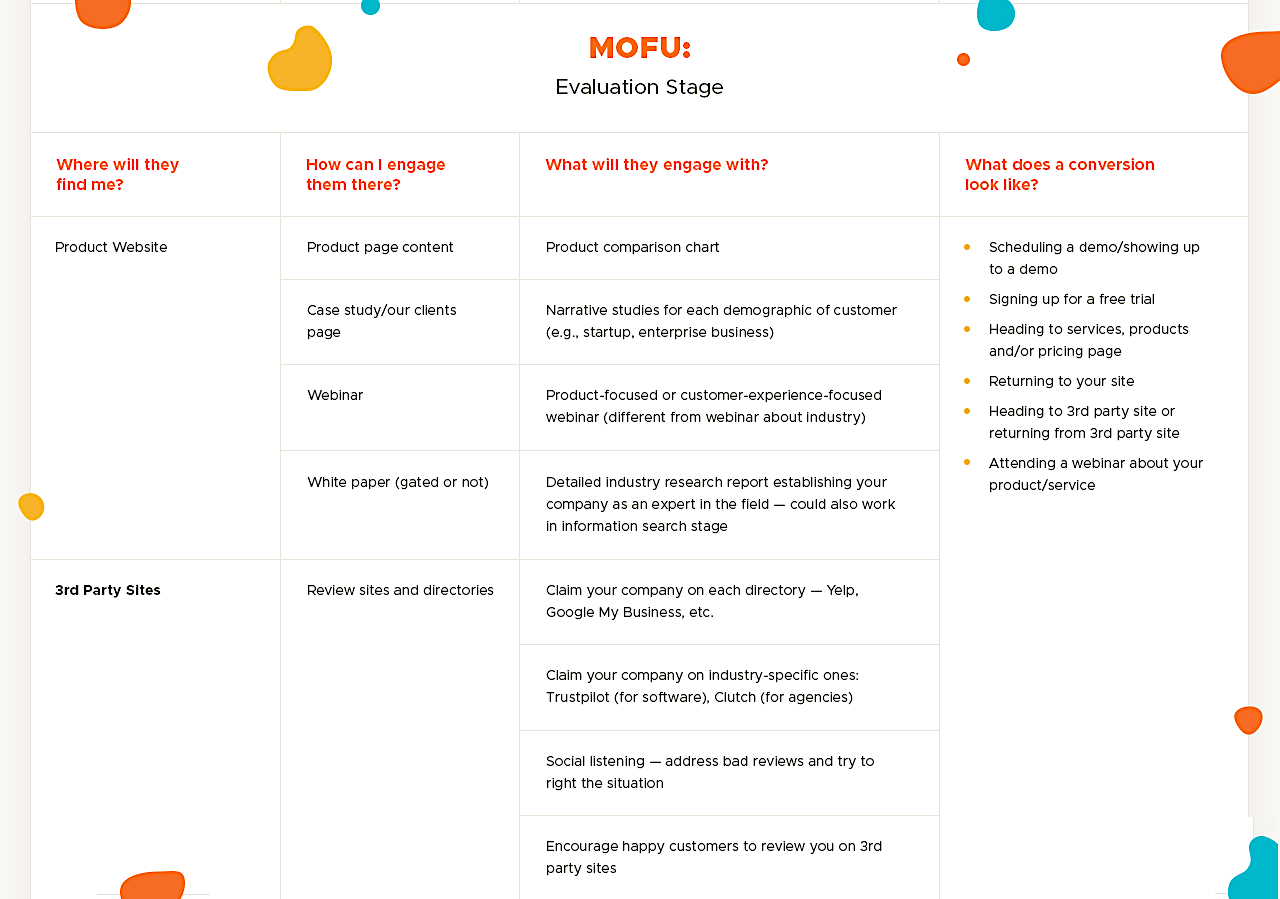
Stage 4 – Purchase Decision (BOFU)
The purchase decision is the natural conclusion of the preceding three stages. The potential customer has determined that they have a problem, investigated their options, decided which one is best for them… and now they're getting ready to pull out their wallets.
At this stage, optimizing your website for conversions (CRO) is an excellent way to increase sales.
You can also provide risk-free trials, money-back guarantees, and similar offers that make purchasing your product or service a no-brainer.
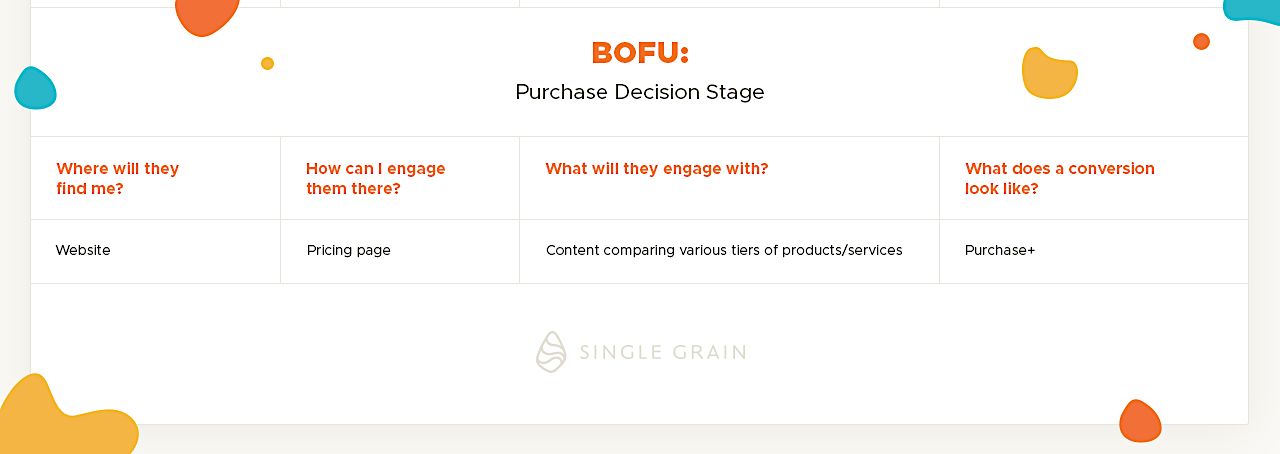
Stage 5 – Post-Purchase Behavior
One more thing. The customer journey isn't over just because a purchase has been made. What happens after the sale is just as important.
If your new customers are greeted by a thoughtful onboarding process, personal attention and all the resources they need to use your product successfully, they're more likely to become loyal customers that refer you to friends and colleagues. And when they're confident, they're more likely to pass on their satisfaction to others in the form of recommendations and product endorsements.
On the other hand, if your new customers experience disappointment after their purchase, they're more likely to request refunds, write negative reviews and recommend that others in their social circles purchase from your competitors.
There's not much content you can create to help facilitate a good post-purchase experience — apart from just creating a great product. If you have a great product that solves a problem, post-purchase behavior will take care of itself.
And t here are certain actions you can take to help facilitate better post-purchase behavior. For example, you could create FAQ content, make it easier to get customer support or solicit feedback on the buying process.
Related Content: 5 Ways to Re-Engage Those Long-Lost Customers
AIDA: Another Way to Remember Content Creation Stages
There's another way to remember the stages of the sales funnel and match them to content creation — with the acronym AIDA:
Whether you prefer the traditional sales funnel stages or the acronym AIDA, the results are the same:
Customers enter the sales funnel and through a process of discernment, choose to either move to an alternative solution or purchase from you. The action at the end of the funnel, or the purchase, concludes the stages of the sales funnel.
Although most people enter the funnel at the top, not everyone does. Some will enter at subsequent stages, but the process remains the same no matter which stage someone enters the sales funnel.
Book My Free Marketing Consultation
How to Build a Marketing Funnel for Your Content
Now that you know how people make decisions, it's time to create your marketing funnel.
As mentioned earlier, one of the main points is choosing which marketing channels to include in your marketing plan. Ideally, you want to do all of the marketing channels below:
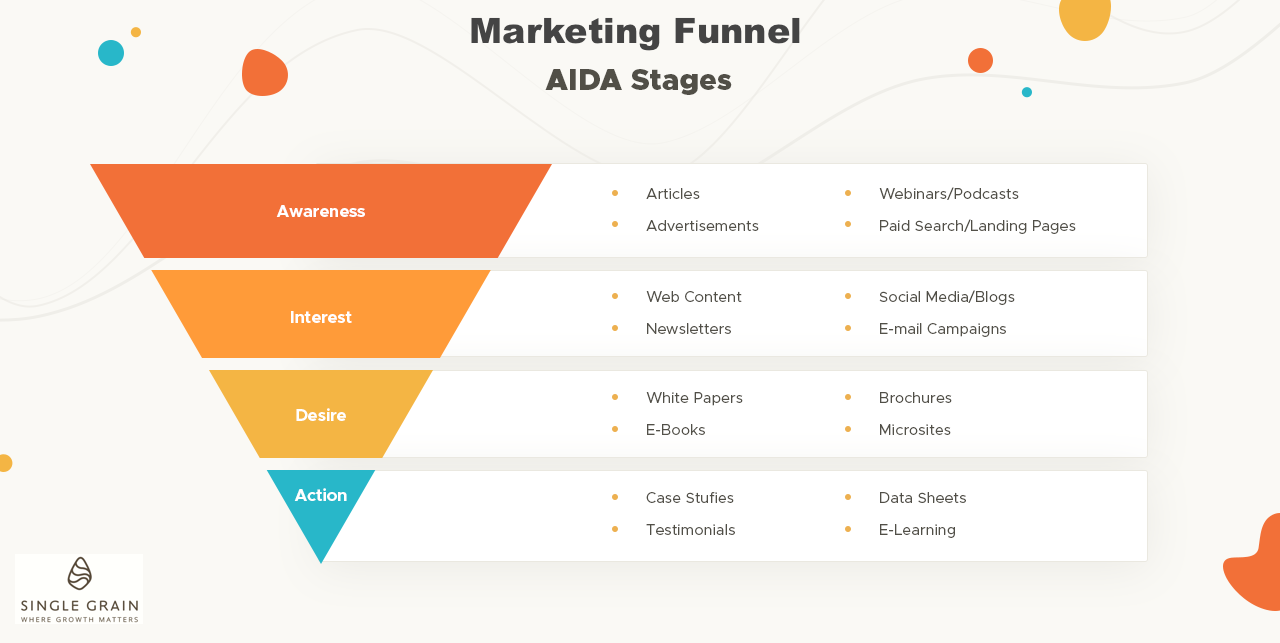
However, the reality is that few companies have the resources to tackle all of these channels (podcasting, paid search, social media, newsletters, e-books, etc.) effectively.
Therefore, although we'll discuss each stage of the funnel, keep in mind that it might be more effective to start at the bottom of the funnel and work your way up, since those already at the bottom of the funnel are much more likely to make a purchase.
Stage 1 Channels – Problem/Need Recognition (TOFU)
Your customer may be vaguely aware that they have an issue, though they may not be actively looking for a solution.
For example, let's say you sell cooling vests that keep outdoor workers cool in the summertime. Your target audience may find that being hot is annoying, but they may not be aware that anything exists to solve it, so they likely won't even be thinking of looking for a solution.
However, if they see or hear an advertisement for a cooling vest, they might have an "aha!" moment and do some further research on the subject.
Therefore, capturing people at this stage is generally going to consist of outbound marketing or advertising. Here are some of the channels that typically attract people at this stage in the process:
- Podcast advertising
- Billboards
- Influencer marketing
- Paid Ads (Facebook, YouTube, Google, etc.)
- Radio ads
- TV ads
- Attending live events
As you can see, most of these channels also double as "brand awareness" channels. Some of them are likely to drive direct conversions (such as paid ads and influencer marketing), though the majority will not.
This is also interruption marketing as the listener/viewer isn't actively searching for a solution – rather, you're hoping they have a pain point that your message can resonate with.
Examples of Marketing Campaigns at This Stage
- You sell a SaaS product and pay for ads on a podcast with a SaaS audience
- You sell beauty products and partner with an influencer to post about it
- You sell plastic surgery services and pay for radio ads to promote it to people in your geography
Action Tip: Discover where and how your competitors have been advertising the longest. If they have been advertising for a long time on a certain platform, it's likely that it's converting well for them .
Purchase Intent: This is the stage farthest from purchase intent. Start by optimizing your website for Stage 4, then Stage 3, then Stage 2, and finally Stage 1.
Stage 2 Channels – Information Search (MOFU)
Now that your customers are interested in finding a solution to their problem, the next step is to create the information they want to know.
At the conclusion of the campaign you ran in Stage 1, you should have included a CTA that points people to either this stage, or a stage further down the funnel.
For simple products that require little information to sell, you can send them directly to the sales page. However, for the sake of showing you each step that can be included in the funnel, we'll assume the product has some complexity and requires some education. In your blog post, it helps you build trust with the audience if you can speak authoritatively on the pain point.
In this case, these are the channels you will probably be leveraging:
- Content marketing (Blog posts, YouTube videos, etc.)
- SEO
- Social media
For most brands, the easiest place to start is writing blog posts. Although it is competitive, there is still room for improvement and, unlike the other channels, the results compound over time.
However, the keywords at this stage will draw a very elementary audience.
For example, if you are an SEO agency, the keywords people will probably search for at this point are:
- "What is SEO?"
- "How to Optimize My Website for Google"
- "What Is Keyword Research?"
- "What Is Link Building?"
At this point, there are plenty of people who are interested in doing SEO on their own, or it may not be a big enough pain point to hire an agency.
These top of the funnel keywords are also quite difficult to rank for, so unless you have already done all of the bottom of the funnel steps we're about to discuss, I recommend against trying to immediately rank for top of funnel keywords.
However, if you have a larger brand and want to rank for these keywords, start by updating content that already ranks within positions 11-20 in the SERPs.
Related Content: Why You Should Update Content – Or Risk Losing The Traffic You Have [Case Study]
Look for 'Striking Distance' Keywords
'Striking distance' keywords are those that are currently in positions 11-20. By using content optimization techniques, you can upgrade your content which will very likely result in it being bumped up onto page one of the SERPs.
The simplest free method to find these is to simply go through your Search Console data and sort queries by position. Or you can use a tool like ClickFlow's Content Decay that finds these posts with heavy traffic loss for you:
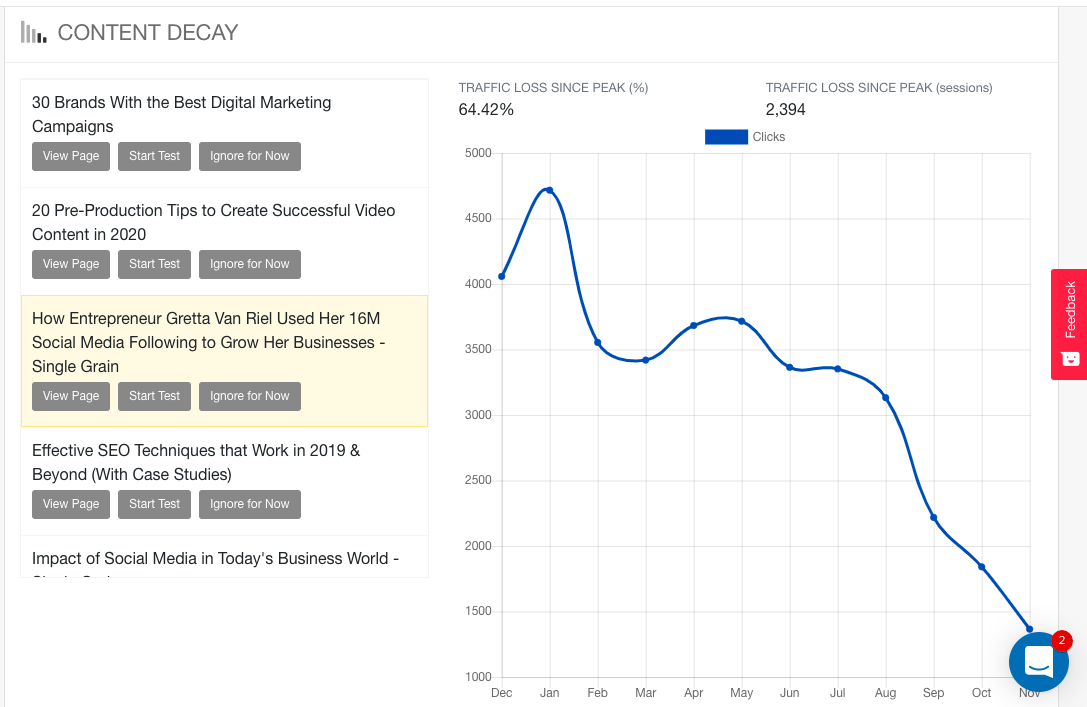
Once you have a list of target pages to upgrade, you can use a tool like ClickFlow's Content Editor feature to make your edits/upgrades:
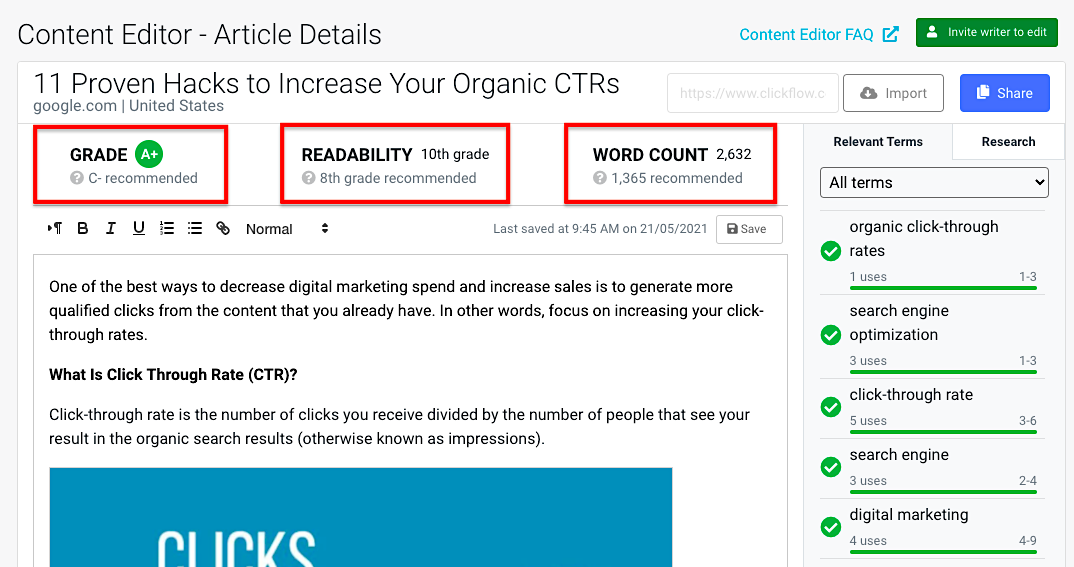
The Content Editor makes it easy to nail the search intent and ensure that you cover all important keywords.
This tool pulls data from the current top-ranking pages to guide your writing. You'll get a recommended word count, recommended keywords and phrases to include, readability feedback, and an overall grade.
Lastly, the Content Editor also helps you cover the most common People Also Ask questions (from Google's SERPs) that are related to your main search term:
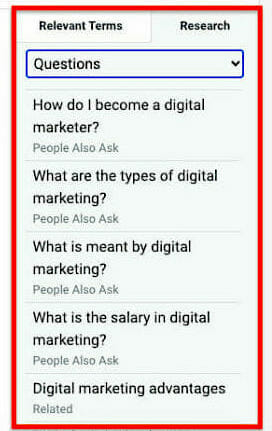
By pulling data from 'Related Searches' and 'People Also Ask', ClickFlow delivers quick suggestions for subheadings and/or FAQs that make it easy for you to answer all the important questions searchers have.
This is extra important in the top of the funnel, where many searches are informational in nature. It also increases the likelihood that you'll grab featured snippets and rank in the PAA section of the SERPs.
Later, you can push these visitors further down the funnel and convert them into buyers.
Nonetheless, if you're absolutely against blogging (for example, if you sell in a super competitive industry like car insurance), here are some additional examples.
Examples of Content at This Stage
- Create content for broader, top of funnel (TOFU) keywords
- Create a YouTube channel that focuses on general how-to, what is, and other early educational topics
- Produce social media content that informs users of basic pain points around your product/service
Action Tip: Discover what the first thing people search for is when they realize they have a problem, and then create content that shows up for that search .
Purchase Intent: This stage is still relatively far from purchase intent. Start by optimizing your website for Stages 4 and 3 first.
Related Content: What Is Content Decay and How It Affects Your SEO
Stage 3 Channels – Evaluation of Alternatives (MOFU)
At this stage of the marketing funnel, your customers know that a solution to their pain point exists. Therefore, the next stage (if they continue down the funnel; most will simply bounce at this point until the pain grows strong enough that they take action) is to evaluate different solutions.
The purchase intent dramatically increases from the previous stage of people merely educating themselves on the pain to actively evaluating solutions.
Therefore, here are a few marketing channels you can try:
- BOFU content marketing (competitor alternatives posts, competitor vs competitor posts, etc.)
- Writing case studies of the product's best users
- Campaigning for more reviews
- Retargeting ads
- Optimizing pricing pages
At this stage, your messaging should be less about educating the audience on the pain point and more about educating them on why your solution solves their pain point the best.
For example, show off any unique features or a pricing model that make your solution preferable to the competition.
Examples of Content at This Stage
For the sake of simplicity, let's pretend you are doing marketing for FreshBooks. In this case, you might:
- Create content for keywords that demonstrate purchase intent like "best accounting software for small businesses"
- Bid for branded competitor keywords like "Quickbooks"
- Create retargeting ads for people who already visited the pricing page
- Optimize the pricing page by building links to it and internally linking
- Send out surveys to current customers and ask all happy, loyal customers to leave reviews
Action Tip: The great thing about this stage is that it is often the cheapest stage to optimize for as it targets a much higher-quality audience . Therefore, exhaust every single one of the steps on this list before moving up the funnel.
Purchase Intent: Purchase intent is very high at this point. If you have limited resources, start here and fully optimize this stage above all else.
Related Content:
* How to Write a Case Study that Converts Prospective Buyers into Customers
* Retargeting 101: Why It's Essential for Any Marketing Funnel
Stage 4 Channels – Purchase Decision (BOFU)
By this stage, you've already done about 99% of the work. Now, all you have to do is make purchasing a no-brainer to turn the prospect into a paying customer.
To accomplish this, you can deploy various CRO tactics.
Here are just a few conversion rate optimization tactics you can leverage:
- Add a 30-day money-back guarantee
- Offer a free trial (or $1 trial to prove intent)
- Offer a pay-by-performance pricing model
- Add customer support chat for last minute objections
- Better yet, add an FAQ section made up of last minute objections
- Add reviews around your purchase page
You can also use a heat map like CrazyEgg that shows where people are scrolling on your website and provide insight on how you can remove roadblocks.
Action Tip: You can either read our guide on CRO, or you can even just hire a CRO expert. You may also want to try different versions of your sales/pricing page to see which one converts the best.
Purchase Intent: People are ready to make a purchase and just want reassurance of the value you will provide them. This should be a priority after stage 3 (usually, if you nail stage 3, they won't have many objections).
Book My Free Marketing Consultation
Qualifying Leads in Your Sales Funnel: MQLs and SQLs
At this point, you have a great marketing campaign outlined.
In order for your marketing funnel to be truly effective, you need to take things one step further by determining how leads will be qualified throughout the process.
This allows you to better utilize salespeople by bringing prospects into the sales process only when then are qualified prospective customers.
Unfortunately, not everyone who makes it through the first few stages of the funnel will be a good fit. As an example, a prospect might complete stages 1-3, but not have the financial resources available to complete the purchase.
Or a lead might be enthusiastic about the product, but is not the decision-maker in his or her organization. While content is helpful in educating all prospective customers and moving them through the different stages of the funnel, you want to understand these two concepts:
- Marketing Qualified Leads (MQLs)
- Sales Qualified Leads (SQLs)
What Is a Marketing Qualified Leads (MQL)?
A marketing qualified lead (MQL) is a prospective customer who has demonstrated a particular level of engagement that leads the marketing team to conclude that real sales potential exists.
The level of complexity involved in this assessment will vary based on the resources available to the team as well as the length of the sales cycle.
You might conclude that anybody that fills out an online demonstration request form is an MQL. Another company might set the bar of MQL qualification at something involving a combination of viewing specific pages, interacting with certain forms, and opening a certain number of email messages. For that kind of analysis, we recommend using a marketing tool that can automate the process.
Once an MQL has been identified, it can be passed on to the sales team for future follow-up.
What Is a Sales Qualified Lead (SQL)?
When a salesperson qualifies a lead and deems it likely to eventually lead to an opportunity, this becomes a sales qualified lead (SQL).
Like MQLs, it's up to your business to determine what that is.
Salespeople qualify the lead by looking at interest and fit. Interest refers to how invested the prospect is in moving forward with your company's type of solution. Fit refers to how closely the lead matches your company's definition of an ideal buyer (e.g., role in company, industry, budget).
This analysis results in four possible primary combinations:
- Low interest/low fit – The leads don't meet your company's target criteria and are unlikely to make a move soon. A common example of this type of lead is the low-level employee who's browsing solutions out of curiosity, not an immediate need.
- High interest/low fit – These MQLs are often people who are searching for a solution, but are unlikely to ultimately go with yours. If, for example, you sell a cloud-based software program and the prospect is clearly more comfortable with a desktop solution, you could be dealing with this type of MQL.
- Low interest/high fit – Typically, these leads closely resemble your target customer, but aren't actively seeking solutions. Even though they may not be a good fit right away, it may still be worth pursuing them to create brand awareness that will pay off down the road when their need becomes apparent.
- High interest/high fit – These MQLs are the "sweet spot" of people who are actively seeking your type of solution and are likely to convert to buyers. These leads should be the highest priority of your sales team.
Sales teams with both junior and senior sales representatives may choose to have junior representatives conduct initial calls to qualify prospects before assigning only those that fall into the "high interest/high fit" category to senior reps for online demonstrations.
The specifics of each stage of qualification aren't particularly important. What is important is that marketing and sales set these parameters.
This helps you identify the marketing campaigns and content leading to the most new qualified prospects, and ensures that you're using your salespeople's time effectively.
Marketing can iterate based on the MQL to SQL conversion rate, as well as feedback from sales. Sales can look at their processes if they're not converting SQLs to purchases.
Related Content:
* MQL vs. SQL – Serve Up The Right Type Of Content To Your Leads
* How to Guide Your Customers Through the Marketing Funnel with Interactive Content
Which Marketing Funnel Metrics Should I Track?
So now you've created your funnel and defined exactly how your personnel will interact with it.
The final step in the process is to figure out which metrics you'll track to determine how well your funnel is functioning. It's crucial to work with the SQL and MQL data here to track patterns between who closes and how they interact with your site, content, channels, ads, etc. Once you have more information, you can continuously optimize your funnel.
A quick word of caution, though. With every piece of content you create for every stage of your funnel, you're generating data. Though all of it is useful to your sales process in some way, it's easy to get bogged down in data and metrics tracking instead of focusing on the few key performance indicators (KPIs) that will actually give you the information needed to make meaningful improvements.
For that reason, while you might want to experiment with tracking all the different metrics below (or any others that you think could be valuable), it's best to choose 2-5 to focus your attention on.
You can always add more later, but be sure you're actually making changes based on the data you generate from these few metrics before expanding your data operations:
- Sales funnel conversion rate – If you're going to choose only a few metrics to focus on, make sure this is one of them. This metric tracks the number of prospects that enter your funnel at any point and how many convert into customers. As you make changes to your marketing strategy in the future, seeing this number improve will let you know you're on the right track.
- Entry sources – Monitoring the sources from which people are entering your funnel can be useful data to track, as it gives you ideas for expanding the reach of your marketing campaigns. If, for example, you see that a large number of your prospects are coming from a single guest blog post you did, you can upgrade and expand on it, add a free consultation opportunity on that blog post, and/or find similar guest author positions.
- Time in stage – In an ideal world, your marketing content would be so compelling that people move from the TOFU to BOFU in a single day. But since that's rarely the case, it's worthwhile to know if your prospects are getting hung up in one of your stages. If so, you'll want to add more content to your site that answers the questions that are unique to this stage of the funnel.
- Exits from stage – Similarly, seeing an excessively high number of people falling out of a particular stage is an indication that you aren't doing enough to answer their questions or you're asking them for too much of a commitment too early. Add more content to give them the information they need to move forward or make it easier for people to convert (e.g. don't ask for a phone number when they're downloading a certain e-book).
- Content piece engagement rate – If you have calls to action on multiple blog posts or other onsite content pieces, you'll want to know which are sending the most converted customers through your funnel so that you can replicate your success by updating that piece of content, sending paid traffic to that blog post, promoting it via email, and/or creating more content pieces like that. Tracking engagement rates on each CTA will give you this information (you can easily set up Google Analytics goals in order to see which posts drive more conversions).
- Opportunity arrival rate – Opportunity arrival rate refers to the number of opportunities that are currently in your funnel. Track this rate and see how changes to your marketing strategy impact it. Ideally, you'll see positive increase in the number of opportunities you're able to generate.
- Close rate – Your close rate (or "win rate") refers to the number of these opportunities that turn into eventual sales. If your close rate is lower than you expect, look at some of the other metrics you're tracking for ideas on improving the success rate of your marketing funnels. You may be sending sales unqualified leads because your content is for a far more technically savvy audience while your ideal customer is a novice.
There are a number of different tools on the market today to help you track these and other metrics, though for most businesses Google Analytics represents the most comprehensive, easy-to-implement solution. Since it's free, use the service's funnel-tracking tools until you determine that you need something more advanced and then move on to another sales analytics program or a complete marketing automation program.
Related Content:
* 9 Mission-Critical Lead Generation Metrics You Need To Track
* Top Marketing KPIs that Every B2B Company Needs to Track
* Google Analytics for Content Marketing: How to Track and Improve Your ROI
Final Words
Make no mistake, creating a sales and marketing funnel using the process described above is no easy feat. This isn't a project you're going to complete in one afternoon — it's a pursuit that you'll want to actively address as long as your company is in business.
Creating a marketing funnel is not a simple undertaking, but it's one of the few opportunities you have to drive significant improvements in your efficiency and effectiveness when closing deals.
Need help with creating high-converting sales funnel? We've got your back! Just click the orange button below 👇
Book My Free Marketing Consultation
Neil Patel Advanced Marketing Program Free Download
Source: https://www.singlegrain.com/blog-posts/content-marketing/how-to-create-marketing-funnel/
Posted by: upshawwishoune1988.blogspot.com

0 Response to "Neil Patel Advanced Marketing Program Free Download"
Post a Comment